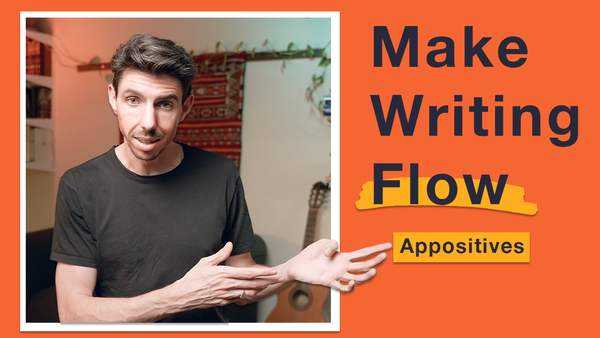The jump from intermediate to advanced writing isn't about not making mistakes. That's basic.
The difference between intermediate and advanced writers is that the latter see grammar not as a list of rules but a set of tools. Like good carpenters, fluent writers know how to choose the right tool for the job.
If you're cutting grass, which tool are you going to pick: the lawnmower, or a pair of scissors?
If you're expressing the definition or a description of something, which kind of clause are you going to pick: an independent clause, a dependent one, or something else?
In this lesson, we'll learn about a great tool that will help you write efficiently and that will promote cohesion in your writing promote.
What Are They?
A noun phrase that gives reader extra information about something in the main clause.
| Minecraft, a popular video game, encourages creativity and critical thinking through its open-world environment. |
Reduction
Appositives are the product of a non-restrictive relative clause that has been reduced.
Non-restrictive relative clauses are commonly used to provide background information about something in a sentence.
Fluent writers maintain coherence by organizing their thoughts into independent clauses. They use dependent clauses for background information, descriptions, and definitions.
On the other hand, fluent writers tend to represent all information in independent clauses, which can make the sentences feel incoherent because they shift focus away from the story being told.
| An appositive is a noun or noun phrase that defines or describes another noun right beside it. It provides additional information or clarification about the noun it follows. |
By making this information dependent, we maintain focus on our main sentence while quietly providing a description or definition.
| An appositive, which is a noun or noun phrase that defines or describes another noun right beside it, provides additional information or clarification about the noun it follows. |
Unlike independent clauses (which form a new thought and carry a lot of emphasis) non-restrictive relative clauses and other dependent clauses can be used to develop the meaning of the main clause in one of three ways:
- to extend
- expand
- or enhance.
One of the most common uses of non-restrictive relative clauses is to define or describe some element in the main clause. Because it’s such a common use of these clauses, the English language evolved to reduce them.
Whenever the non-restrictive relative clause uses the verb to be, we reduce it by following these two steps.
- Delete the pronoun.
| An appositive, |
2. Delete the verb to be.
| An appositive, |
And what we’re left with is the subject complement of the linking verb, either a noun or adjectival phrase.
| An appositive, a noun or noun phrase that defines or describes another noun right beside it, provides additional information or clarification about the noun it follows. |
Two Kinds of Appositives
1. Essential
The information in the appositive is vital in identifying the previous noun. Without the appositive, the sentence doesn’t make sense.
These appositives serve to identify the referent of the noun. In other words, they restrict the field of meaning, specifying which member of the noun group is being referred to.
| Did you watch the film starring Leonardo Dicaprio, Inception? |
| Did you watch the film starring Leonardo Dicaprio, |

2. Optional
The appositive adds information about the noun, but it is non-essential.
These appositives serve to describe the noun, not to identify its referent. In other words, they are non-restrictive; they’re adjectives, essentially.
| J.K. Rowling, the author of the Harry Potter series, is the guest on today’s podcast. |
| J.K. Rowling |
Makes sense without the appositive.
Position & Commas
The appositive is always positioned next to the noun. It can go on either side of the noun depending on how you choose to organize the sentence.
| Albert Einstein, a famous physicist, is best remembered for his theory of relativity. |
| A famous physicist, Albert Einstein is best remembered for his theory of relativity. |
| The year 1905, which saw the publication of four papers that would transform the way we see the universe by Albert Einstein, a now famous physicist, is known as his annus mirabilis. |
